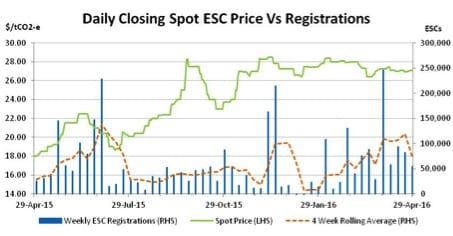Coming off the back of the staggering price volatility seen in the second half of 2015 and with a host of changes taking effect in the New Year, early 2016 was always likely to prove an eventful period for Victoria’s Energy Efficiency market. And it hasn’t disappointed, with considerable price movements alongside strong trading volumes, coinciding with the scheme’s successful transition from a largely residential focus, to a far more commercial one.
Victorian Energy Efficiency Certificates (VEECs)

The heady days of the second half of 2015 in which the spot VEEC price doubled between early July and October, before then surrendering much of those gains in a matter of days, was unlikely to be replicated in early 2016, and no bad thing.
Yet the beginning of the year brought with it a number of significant changes to the scheme, not least of all the introduction of extended operating hours for commercial lighting installations. Aside from demand leading into the 2015 compliance period (final date being end of April 16), the major factor impacting on price has been the rise of commercial lighting VEEC supply across this period.
Whilst commercial lighting had been part of the scheme for several years, a generic cap on energy savings of 3000 hours meant that all premises were treated as if operating purely on the basis of office hours, thus not recognising the true energy savings from replacing lighting on premises that operate for a greater proportion of the day. Looking back across the first half of 2015, commercial lighting constituted 5% of total VEEC creation. Fast forward to April 2016, following the introduction of extended operating hours in January, and commercial lighting was responsible for over 40% of total VEEC creation.

The spot VEEC market began the year in the mid $25s and, after a generally stable start, lost ground sharply in early February to $22 following strong supply numbers for January’s end of compliance cut-off date. From there the market recovered gradually across the month reaching a high of $24.50 in the first half of March. Yet all the while the strong VEEC creation numbers, buoyed in large part by commercial lighting activity mounted, eventually ushering in another downward run that saw the spot close April at $20.50.

Early 2016 continued to see a very active forward market with constant activity out as far as early 2017, with a smattering of transactions going further out than that. Indeed, as has been the case in recent years, total volume traded in the forward VEEC market is considerably larger than in the spot.
The forward curve spent much of the time relatively flat to spot, though, in a situation that is relatively uncommon, there were also times where the spot market was trading above the forward curve and vice versa.
Looking forward, it appears the major factor influencing the VEEC market will be the growth of commercial lighting activity and its impact on the VEEC surplus. Taking into account a modest over surrender in the 2015 compliance year (5.6m VEECs were surrendered against a nominal target of 5.4m), a surplus of roughly 1m VEECs was rolled over into 2016. However, should the current rate of VEEC creation be sustained across the year, by the end of January that surplus will have grown to 3m VEECs.
New South Wales Energy Savings Certificates (ESCs)

In a year in which the scheme’s target will increase by circa 1m ESCs, a healthy increase in ESC supply in recent months has failed to thus far materially impact on prices, which have remained range bound across the early part of the year.
The spot ESC market ended 2015 trading within a $26.50-$28.00 range. While ESC registration numbers began 2016 in particularly modest fashion, the last two months have brought a marked increase in supply.

Still, spot ESC prices have remained largely stable, something which has intrigued some participants given the healthy size of the ESC surplus (circa 2.5m). The price stability has been ascribed to the fact that the target for 2016 increases to 7% or approximately 3.7m, an increase of roughly 1m on 2015.
An increase of this magnitude was expected to result in the progressive erosion of the ESC surplus in the 2016 compliance year. However, were the current rate registrations to be maintained across the year it appears the surplus would be maintained, which has some questioning whether the current pricing levels will continue to be justified.
In contrast to its Victorian counterpart, the ESC market continues to be dominated by activity in the commercial/industrial sectors, while activity in the residential arena is nonexistent. Despite several rounds of alteration (over several years) to the Home Energy Efficiency Retrofit methodology, aimed at encouraging such activity, the sector remains dormant.
Given the potential contribution to ESC supply that could come given the available residential opportunities and the number of businesses geared up to cater to that market, there are many hoping that further changes will follow at some point later in the year.
Marco Stella is Senior Broker, Environmental Markets at TFS Green Australia. The TFS Green Australia team provides project and transactional environmental market brokerage and data services, across all domestic and international renewable energy, energy efficiency and carbon markets.







